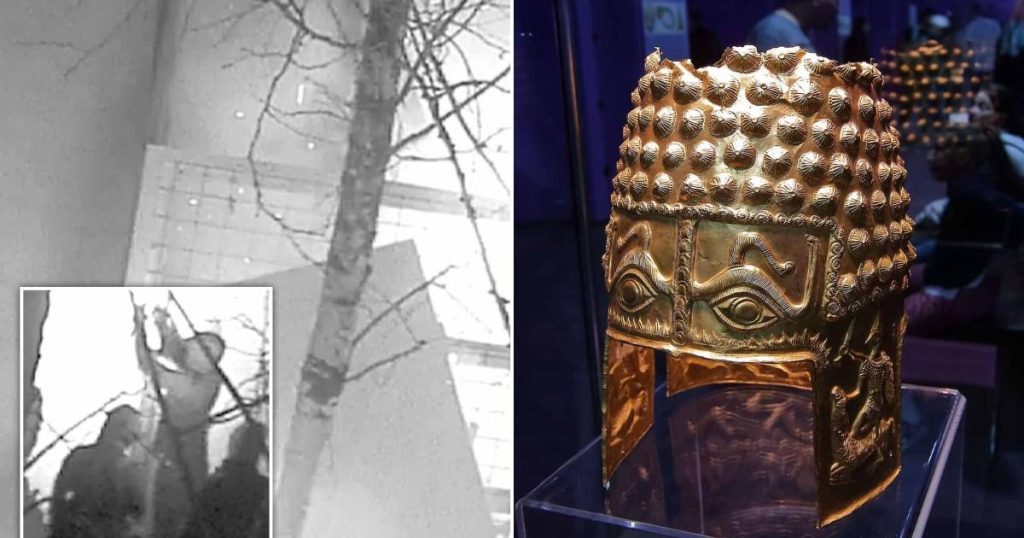A brazen heist involving explosives rocked the Drents Museum in Assen, Netherlands, in the early hours of Saturday morning, resulting in the theft of several invaluable Romanian artifacts. Security footage captured three masked individuals forcibly entering the museum, followed by a powerful explosion. Minutes later, the same individuals were seen fleeing the scene. Among the stolen items were three Dacian royal bracelets and the centerpiece of the exhibition, the Golden Helmet of Cotofenesti. This helmet, dating back to approximately 450 BCE, is considered a national treasure of Romania and a symbol of its ancient Dacian heritage. The artifacts were on loan from the National History Museum in Bucharest and formed part of an exhibit showcasing the history of the ancient kingdom of Dacia, located in present-day Romania.
The use of explosives in this robbery has raised significant concerns among authorities and art experts. Interpol has been called in to assist in the large-scale investigation, as fears mount that the stolen gold artifacts will be melted down, erasing their historical and cultural significance. Arthur Brand, a renowned art detective who has recovered stolen masterpieces in the past, commented on the growing trend of using explosives in art heists in the Netherlands. He expressed alarm at the effectiveness of this method and urged police and government officials to address the issue swiftly. Brand emphasized the devastating implications of melting down stolen gold, highlighting the irreversible loss of precious cultural heritage.
The Golden Helmet of Cotofenesti, crafted from solid gold, holds immense cultural and historical importance for Romania. It’s a prominent feature in Romanian history books and is considered a national icon. Romanian President Klaus Iohannis described the helmet as “priceless” and expressed his deep concern over its theft. He confirmed that Dutch Prime Minister Mark Rutte had assured him that all necessary measures were being taken to apprehend the perpetrators and recover the stolen artifacts. The theft represents a significant loss not only for Romania but for the global cultural heritage community.
The Drents Museum robbery follows a disturbing pattern of art heists involving explosives in the Netherlands. This trend, as pointed out by Arthur Brand, raises serious questions about security measures in Dutch museums and the increasing boldness of art thieves. The use of explosives not only facilitates the theft but also risks damaging other artifacts and endangering museum staff and visitors. The fact that such a method is becoming increasingly prevalent underscores the urgent need for improved security protocols and a more coordinated response from law enforcement agencies.
The investigation into the Drents Museum robbery is focused on identifying the masked individuals captured in the CCTV footage and examining a suspicious car fire near Rolde, which authorities believe may be connected to the crime. It is suspected that the perpetrators may have switched vehicles after setting the car ablaze. Dutch police have released images of the suspects and appealed to the public for any information that could aid in their identification and apprehension. The international scope of the investigation, involving Interpol, highlights the seriousness of the crime and the commitment to recovering the stolen artifacts.
The theft of the Dacian artifacts, particularly the Golden Helmet of Cotofenesti, represents a significant loss for Romania and the world’s cultural heritage. The incident underscores the vulnerability of museums to sophisticated criminal operations and the need for enhanced security measures to protect priceless artifacts. The use of explosives in this heist adds another layer of complexity to the problem and highlights the growing audacity of art thieves. The international collaboration between law enforcement agencies, as seen with Interpol’s involvement, is crucial in addressing these transnational crimes and recovering stolen cultural property. The recovery of the artifacts remains the top priority for both Romanian and Dutch authorities, who are working tirelessly to bring the perpetrators to justice and restore these treasures to their rightful place.




